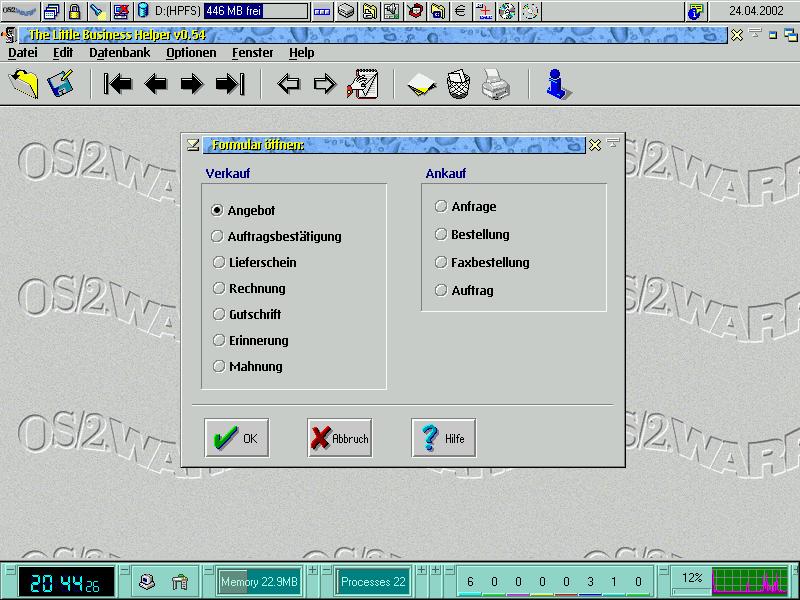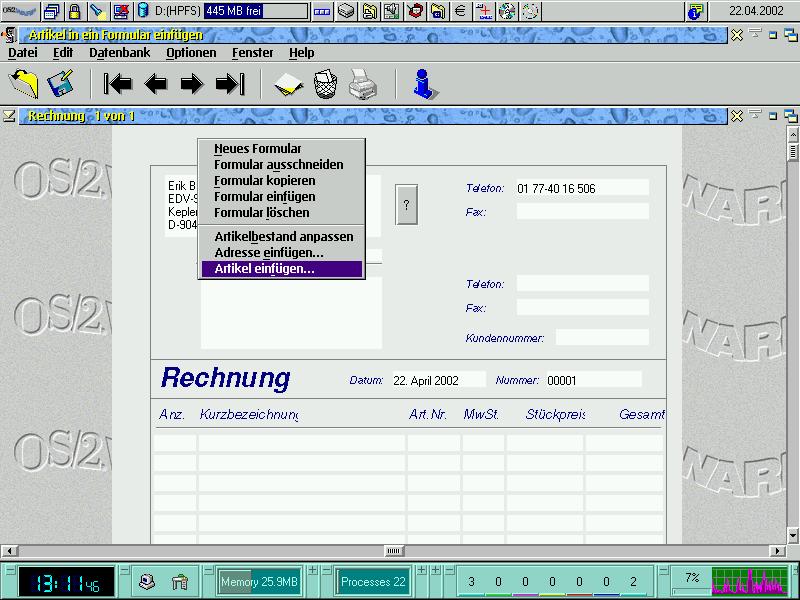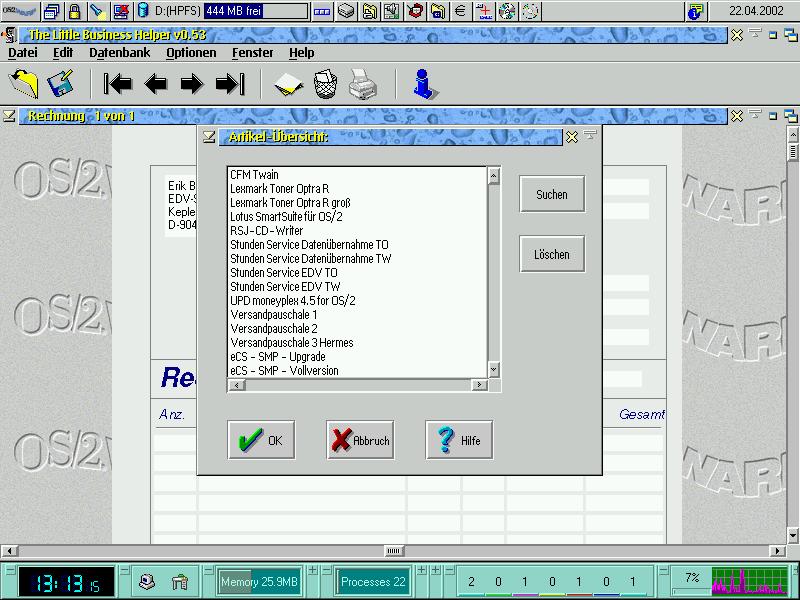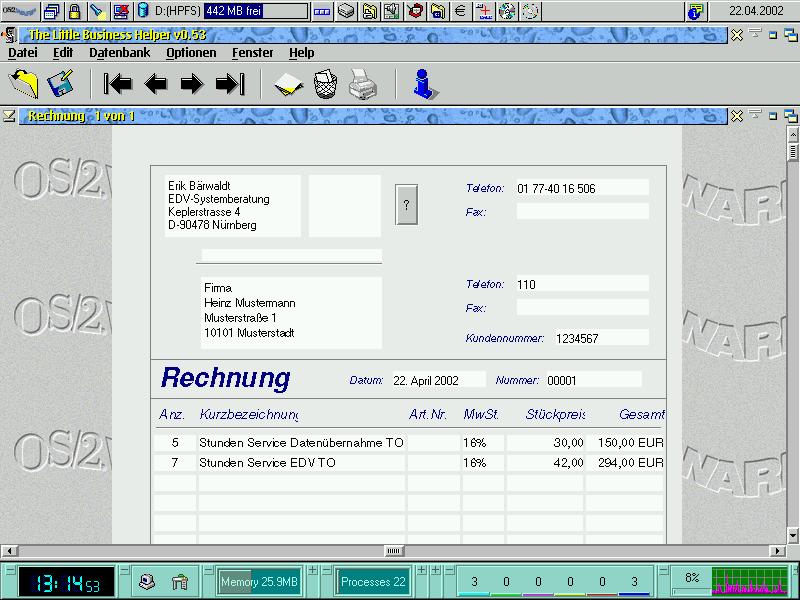
VOICE Home Page: http://www.os2voice.org
[Newsletter Index]
[Previous Page] [Next Page]
[Feature Index]

VOICE Home Page: http://www.os2voice.org |
June 2002
[Newsletter Index]
|
| By Eric Baerwaldt © June 2002, Translation: Christian Hennecke |
[Editor's note: While the application that is reviewed in this article is currently only available in German, we found it interesting enough for our international readers. If someone with the proper knowledge of business terms would offer his/her help, an English version shouldn't be too far away.]
Success and spread of an operating system is exceedingly dependent on user acceptance. The key user is in fact not the consumer, but rather small to medium-sized enterprises, as well as large enterprises. Where would OS/2 Warp be today without large banks and insurance companies that still use this outstanding system? After all it is mainly they who are responsible for OS/2 in all its versions still being installed on nearly 600.000 systems in Germany. Hence it holds a larger market-share among all non-Windows systems than all Unix derivatives combined, including the much hyped Linux.
But the business world does not only consist of banks and insurance companies and during the last few years anyone could see many software developers of sectoral applications turning away from OS/2. "That system is dead" could be heard again and again, and even those packages that had been developed as native OS/2 applications with a price in the five-digit area were not developed any further for the most part. With introduction of the Euro, these systems' geese were ultimately cooked.
Small to medium-sized companies usually do not employ large ERP systems (Enterprise Resource Planning), but a subset of those. While an ERP system registers each and every event that is relevant to the operational course of business as well as a strategic area, the subset systems' functionality is restricted to improve the efficiency of operational organization of a company only. This means that areas such as human resources planning, that are not directly related to the core business directly, are left out in those subset systems.
So what must these smaller ERP systems always be able to perform? As a basic principle they have to be able to register and picture all business events that usually accrue in organization. In a stricter sense, these events are the complete purchasing, the entire customer service from submitting bids via written confirmations of orders, bills of lading to accounts receivable and collections. Moreover, a sophisticated system has to be able to manage one or more warehouses within the scope of purchasing. And finally it has to offer meaningful customer information management.
Up to now things looked bad for OS/2 Warp for such "all inclusive" packages - as described above. In my long standing experience I had to resort to stone old DOS programs to avoid having to use the penalty box or installation orgies like with Odin. Both market leaders' products , BFB's small ERP system WAWI 2000 and SageKHK's Classic Line, were up to the standards of a well-engineered small ERP system. The old DOS programs' continuously very complex user interfaces that do not comply with any conventions and the resulting - sometimes extremely so - complicated handling are very annoying though. Sporadically they don't even have standardized key commands throughout the different application modules. Even the inexperienced user will note that these programs were not designed by practitioners, but by ambitious computer scientists, who exerted themselves to get up to operational standards, but didn't have an eye on the requirements of the end-user. It's a pity if one has to use such modules from the stone-age on the most modern object-oriented interface.
But there is a clear ray of hope. Some weeks ago student and programmer Andreas Schoesser introduced his Little Business Helper - at version 0.53 which he himself calls an unfinished beta version. I have downloaded the program and installed it in spite of my initial uneasy feeling due to the low version number. What awaited me has exhilarated me, although there is still much to do to bring the program up to the functional level of the "big" small ERP systems.
Initially it has struck me with the first run of LBH that a practitioner is developing for practitioners: You don't have to make yourself acquainted with cryptic key combinations to be able to create a customer in the system at all. Neither is it required to lay out billing forms in a complicated way - with LBH a rather impressively simple concept has been realized, that quickly allows any beginner to make effective use of the computer. The necessary period of adjustment for this software - a criteria that is not to be underestimated regarding the decision-making pro or against a new product in enterprises - is minimized that way.
Furthermore, the loading speed stands out already at the first start of the application. Even most DOS applications are not operationally faster, not to mention software that is running on the 90%+ systems. Thus you can work at decent speed. LBH makes use of OS/2-specific things extensively, so the operating system's superiority shines for the user.
And - according to the saying that good things come in three's - I would like to point out the program's already very good stability. LBH doesn't show any soft spot in that area either.
So what does the application offer in detail?
After the first start the user is presented with an interface that looks a bit Spartan at first: The screen is empty except for a menu and an icon bar. If you click on the folder icon at the outer left, the form window is opened.

Now the user can choose which form he wants to fill out - the palette of predefined forms covers all the relevant areas and is also clearly separated into the categories purchase and sales.
After selection of the respective form - a bill template in our case - the complete bill is displayed on the screen:

Now the bill can, as every other form, either be filled out by the user directly, or the fields can be filled with records from the standing data. In this example we click on the field for the customer address and with a right-click we open a context menu from which the customer base can be selected. Then a new window opens with the respective choices and you can select and copy a customer to the address field by double-clicking on it with the left mouse button. No cumbersome searching in databases with match codes, no tedious entering of multi-digit customer codes (which get more error-prone with the number of digits).
If you then enter the amount of units of a sold article and then click on the description field, you can again select an article from the standing data via the right mouse button.

A double-click with the left mouse button transfers the selected article to the form. In doing so, LBH automatically calculates the billing amount and inserts it into the form, as well as the total balance and VAT. It doesn't get any faster and easier!

Note that - as in our example - services can also be added to the standing data for articles. Then you just have to enter the number of hours spent - LBH does the rest.
Writing bids, bills of deliverance, orders, etc. follows exactly the same workflow, so no additional period of adjustment is required. Any bills, offerings etc. that have been written can be looked at again without problems via LBH's browsing feature in the main screen.
I will not conceal the fact that LBH already includes features for automated ordering and dunning. Those offer a considerable advantage for the user, because outstanding items don't have to be checked by hand, which can be a very tiresome task depending on the number of bills.
One reason why Andreas Schösser has published »Little Business Helper« at such an early stage is to get feedback and suggestions from users, so he can form it to fit the requirements of practitioners better. First of all the developer plans to implement some sectoral facilitations and to remove some restrictions like the number of forms. This consequential development should ensure that LBH should be able to open a broader, intersectoral spectrum of possible appliances. Due to the impressive concept and the high fitness for practical use, LBH could make OS/2 and eCS "presentable" at companies, who haven't seen them fit as an alternative to the 90+ percent solutions so far because of the lack of native support for sectoral standard applications.
References:
Little Business Helper 0.54 |
[Feature Index]
editor@os2voice.org
[Previous Page] [Newsletter Index] [Next Page]
VOICE Home Page: http://www.os2voice.org